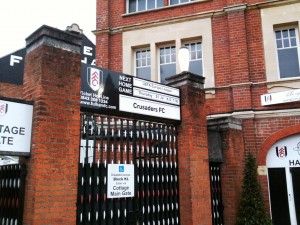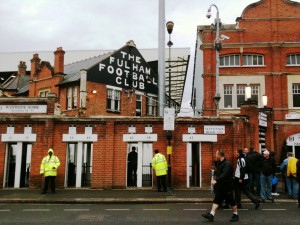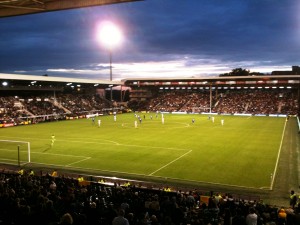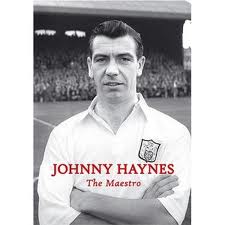 As a football fan, there are games and players from the past that you wish you had been able to see. For me attempting to pick just one Fulham fixture where I wish I could have attended is a mightily difficult task. However, when it comes to the player I most wish I could have seen, well that it a different matter – quite simply, John Norman (Johnny) Haynes. The Maestro played his last first team game at Craven Cottage on Saturday 17 January 1970 against Stockport County. It wasn’t until two years later that I made my first visit to The Cottage, by which time Johnny was gracing the football fields of South Africa. Therefore in reading and reviewing this book I make no apology that I have done so as very much a Fulham fan and with an eagerness to discover so much more about this legend.
As a football fan, there are games and players from the past that you wish you had been able to see. For me attempting to pick just one Fulham fixture where I wish I could have attended is a mightily difficult task. However, when it comes to the player I most wish I could have seen, well that it a different matter – quite simply, John Norman (Johnny) Haynes. The Maestro played his last first team game at Craven Cottage on Saturday 17 January 1970 against Stockport County. It wasn’t until two years later that I made my first visit to The Cottage, by which time Johnny was gracing the football fields of South Africa. Therefore in reading and reviewing this book I make no apology that I have done so as very much a Fulham fan and with an eagerness to discover so much more about this legend.
The first thing to say about this book, in its physical sense, is that it is an object of beauty. This A4 sized tome, rather like Haynes’ himself exudes class. The portrait of Johnny on the cover is classic in its simplicity, whilst inside the reader is treated to a layout, text and paper quality that is a joy to behold. I fell in love with the book even before reading a word; as an object it is in itself a quality item.
So does the content live up to the aesthetic qualities of this publication? Before the main chapters of the book, there are usual forewords, acknowledgments, and contents pages. However, there is also a Notes to the text page, which I found invaluable. The reason being is that it puts into context what football was like during the 1950’s and 60’s; an incredibly different beast both domestically and internationally to that which current fans watch and understand. The main body of book itself is split over thirty-two chapters, which apart from the first three follow Haynes’ life chronologically. The first three chapters each take a different perspective of aspects of Johnny Haynes the player and person. So within the opening part of this publication the reader is given a summary of the footballing attributes, the all-round sporting ability and a look at Haynes’ overall character. Indeed, the authors of the book (Martin Plumb and Ken Coton) ensure that this volume isn’t simply a sycophantic view of the Fulham favourite, as in chapter three, A Jekyll and Hyde character? they explore and acknowledge that, “…like all exceptional talents his (Haynes’) greatness came as part of a complete package alongside his faults and frailties…”
Chapters four, five and six, look at Johnny as a boy and his progression through school and district teams to England Schoolboy Honours and his eventual signing of professional forms for Fulham. Chapter seven begins a season by season (and game by game) analysis of Johnny Haynes’ career, starting with the 1952/53 season and his debut on Boxing Day 1952 against Southampton at The Cottage. The year on year approach allows the reader to see each season progress and Haynes’ part in it. Therefore we see each significant milestone in its timeline. Over the coming seasons, whilst Fulham continue to battle for promotion from Division Two, Johnny goes from strength to strength as England B, Under 23 and Full Honours are attained, as well as playing for the Football League Representative team and taking part in the Inter-Cities Fairs Cup for the London XI. His development is such, that by the 1956/57 season at the age of 21 Johnny Haynes is made Fulham captain.
The following campaign in 1957/58 was a case of near, yet so far. Fulham ultimately missed out on promotion and were beaten in the FA Cup Semi-Final after a replay, to a Manchester United team emerging from the shadows of the Munich air disaster. That summer Johnny Haynes played for England in the 1958 World Cup Finals in Sweden. After the near miss of the previous year, in 1958/59 Haynes leads Fulham to promotion in Bedford Jezzard’s first season as manager.
 It is interesting to reflect that with Fulham having been promoted to the First Division and Haynes made England captain during the 1959/60 season that all seemed right with the world. However, it could be seen as the start of a period of struggle for Fulham which obviously had an impact on its captain and focal point. From this season onwards each year The Cottagers battled relegation from the top flight until in 1967/68 they ran out of luck. During that time much happened to Johnny Haynes. In terms of his England career, his finest hour came on April 15 1961 when he led England to an astonishing 9-3 victory over Scotland at Wembley. He then experienced his second World Cup Finals tournament in Chile in 1962. However, England departed at the Quarter Final stage 3-1 to Brazil. He very much split the football critics of the time, with opinion divided on whether Haynes was the right man around which England should play.
It is interesting to reflect that with Fulham having been promoted to the First Division and Haynes made England captain during the 1959/60 season that all seemed right with the world. However, it could be seen as the start of a period of struggle for Fulham which obviously had an impact on its captain and focal point. From this season onwards each year The Cottagers battled relegation from the top flight until in 1967/68 they ran out of luck. During that time much happened to Johnny Haynes. In terms of his England career, his finest hour came on April 15 1961 when he led England to an astonishing 9-3 victory over Scotland at Wembley. He then experienced his second World Cup Finals tournament in Chile in 1962. However, England departed at the Quarter Final stage 3-1 to Brazil. He very much split the football critics of the time, with opinion divided on whether Haynes was the right man around which England should play.
For Fulham, Haynes famously became the first £100 a week player in 1960/61, against a background of transfer speculation and another failed FA Cup Semi-Final. At the start of the 1962/63 season Haynes was involved in a serious car accident in which he broke bones in both legs and damaged a cruciate ligament in his right knee. Whilst he did recover to continue his playing career, in later life Haynes observed, “…it was the cruciate ligament in the right knee that did for me. They used to stitch them together, but it didn’t work like the operations today. For me it was a big struggle and I was, more or less, playing on one leg…”
This was obviously a turning point in the career of Johnny Haynes and as a reader I felt a sadness as he struggled with the injury, the loss of his England career (and ultimately any chance of selection for the 1966 World Cup winning squad) and the constant battle to keep Fulham in the top flight. Rumours surfaced again during these years of a transfer away from The Cottage and Haynes endured testing years during the management reign of Vic Buckingham. As if the relegation in 1967/68 of Fulham was bad enough, the following season offered no respite in Division Two. The Cottagers would ultimately suffer a second successive relegation. They were indeed desperate times down by The Thames. The madness and sadness of it all is summed up in the following episode from the game against Carlisle United in February 1969. Fulham were playing poorly and manager Bill Dodgin was about to replace Malcolm Macdonald with Jimmy Conway. However, “…Johnny Haynes suddenly walked off the pitch with a shrug of the shoulders and disappeared into the tunnel…the truth was that Haynes was totally fed up with the whole episode and since every member of the team was playing so badly, and anyone could have gone off, he decided to make the decision himself and go…”
The Maestro did have a testimonial game on April 28 1969 and a crowd of nearly 25,000 came to celebrate the career of Fulham’s greatest ever player. However, the occasion was tinged with sadness; “…many tributes were made to the maestro – Johnny the Greatest, the Magician, and the miracle Worker. The club conceded that the decline in their own status had probably coincided with the inevitable decline in Haynes’ own career…”
In the 1969/70 season Johnny Haynes played his last first team game in Football League Division Three in a 1-1 draw against Stockport County in January 1970. Fulham sought to rebuild the team for the remainder of the season and the following year would be promoted to Division Two without Haynes. Whilst that was the end of his career at The Cottage, Johnny Haynes moved to South Africa and played until the mid 70’s at Durban City, Durban United, Durban Celtic and finally Maritzburg.
In 1985 Haynes returned to Britain, settling in Edinburgh for the remainder of his life. He never took up a role as a football pundit or really become involved in the game in any real way. However, his love for Fulham never diminished and he was a leading figure in the successful bid to save the club during the dark days of the 90’s. Thankfully he was around to see Fulham promoted to the top flight of English football and visited The Cottage on a number of occasions. As a mark of Haynes’ contribution to the world of football, in 2002 he was an inaugural inductee to the English Football Hall of Fame.
The final two chapters of the book close the story of The Maestro. Chapter thirty-one is an excellent section of statistics covering his Fulham and England career, whilst Chapter thirty-two is the Epilogue. This details the events of October 2005 when a car accident lead to Johnny’s death and also contains tributes from across the football world.
Fulham renamed the Stevenage Road stand The Johnny Haynes Stand with the dedication taking place on August 26 2006 at the home game against Sheffield United. On October 18 2008 a statue of the Legend was unveiled before the home game against Sunderland. Martin Plumb and Ken Coton have produced a brilliantly researched book which sits alongside these as an equally fitting tribute to Johnny Haynes – The Maestro.
For copies of this book and other Ashwater Press publications, please go to: http://www.ashwaterpress.co.uk/
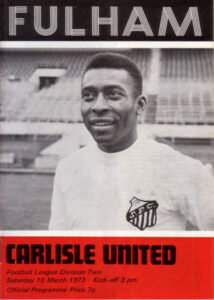 The debate about the Greatest of All Time will continue as long as the game of football is played and thanks to the internet, footage of those greats from down the years allows us to compare players from different eras. However, there is nothing like being able to say that you saw them play in the flesh. And I can humbly say that I was able to see ‘live’ the player who at the time was probably the most famous and greatest player on the planet – Edson Arantes do Nascimento or as the world knew him – Pele.
The debate about the Greatest of All Time will continue as long as the game of football is played and thanks to the internet, footage of those greats from down the years allows us to compare players from different eras. However, there is nothing like being able to say that you saw them play in the flesh. And I can humbly say that I was able to see ‘live’ the player who at the time was probably the most famous and greatest player on the planet – Edson Arantes do Nascimento or as the world knew him – Pele. Given that there would be a bumper crowd we got seats in the Stevenage Road Stand rather than our usual spot on the Putney End terrace. Fulham averaged just over 10,000 in the league that season, but for the Santos game it was officially recorded as 21,464 – the biggest attendance I’d seen at the Cottage up till then.
Given that there would be a bumper crowd we got seats in the Stevenage Road Stand rather than our usual spot on the Putney End terrace. Fulham averaged just over 10,000 in the league that season, but for the Santos game it was officially recorded as 21,464 – the biggest attendance I’d seen at the Cottage up till then. With global coverage of the English Premier League, and the reach of social media, you are just as likely to see fans wearing the colours of Arsenal, Chelsea, Liverpool, Manchester City and United in the bars of Beijing, New York, Sydney and Tokyo, as you would back in London, Liverpool and Manchester. Given the effort that these Clubs put into attracting overseas fans, i.e. with trips to play in friendlies and tournaments abroad, it was a pleasant surprise to read Please Don’t Take Me Home: A Lovestory with Fulham Football Club, a story of an Italian who has come to love the club from Craven Cottage – who despite recent years in the Premier League, cannot be considered one of the ‘big hitters’ in English football.
With global coverage of the English Premier League, and the reach of social media, you are just as likely to see fans wearing the colours of Arsenal, Chelsea, Liverpool, Manchester City and United in the bars of Beijing, New York, Sydney and Tokyo, as you would back in London, Liverpool and Manchester. Given the effort that these Clubs put into attracting overseas fans, i.e. with trips to play in friendlies and tournaments abroad, it was a pleasant surprise to read Please Don’t Take Me Home: A Lovestory with Fulham Football Club, a story of an Italian who has come to love the club from Craven Cottage – who despite recent years in the Premier League, cannot be considered one of the ‘big hitters’ in English football.
 As a kid travelling to away games, spotting the floodlights was part of the excitement of the day. And if I’m honest, even all these years later, there is still a thrill from spotting the pylons whether in the car or on a train. However, as old grounds have slowly disappeared and technology has advanced in the field of lighting, those distinctive pylons of my youth, are a very rare sight these days.
As a kid travelling to away games, spotting the floodlights was part of the excitement of the day. And if I’m honest, even all these years later, there is still a thrill from spotting the pylons whether in the car or on a train. However, as old grounds have slowly disappeared and technology has advanced in the field of lighting, those distinctive pylons of my youth, are a very rare sight these days. As a football fan, there are games and players from the past that you wish you had been able to see. For me attempting to pick just one Fulham fixture where I wish I could have attended is a mightily difficult task. However, when it comes to the player I most wish I could have seen, well that it a different matter – quite simply, John Norman (Johnny) Haynes. The Maestro played his last first team game at Craven Cottage on Saturday 17 January 1970 against Stockport County. It wasn’t until two years later that I made my first visit to The Cottage, by which time Johnny was gracing the football fields of South Africa. Therefore in reading and reviewing this book I make no apology that I have done so as very much a Fulham fan and with an eagerness to discover so much more about this legend.
As a football fan, there are games and players from the past that you wish you had been able to see. For me attempting to pick just one Fulham fixture where I wish I could have attended is a mightily difficult task. However, when it comes to the player I most wish I could have seen, well that it a different matter – quite simply, John Norman (Johnny) Haynes. The Maestro played his last first team game at Craven Cottage on Saturday 17 January 1970 against Stockport County. It wasn’t until two years later that I made my first visit to The Cottage, by which time Johnny was gracing the football fields of South Africa. Therefore in reading and reviewing this book I make no apology that I have done so as very much a Fulham fan and with an eagerness to discover so much more about this legend. It is interesting to reflect that with Fulham having been promoted to the First Division and Haynes made England captain during the 1959/60 season that all seemed right with the world. However, it could be seen as the start of a period of struggle for Fulham which obviously had an impact on its captain and focal point. From this season onwards each year The Cottagers battled relegation from the top flight until in 1967/68 they ran out of luck. During that time much happened to Johnny Haynes. In terms of his England career, his finest hour came on April 15 1961 when he led England to an astonishing 9-3 victory over Scotland at Wembley. He then experienced his second World Cup Finals tournament in Chile in 1962. However, England departed at the Quarter Final stage 3-1 to Brazil. He very much split the football critics of the time, with opinion divided on whether Haynes was the right man around which England should play.
It is interesting to reflect that with Fulham having been promoted to the First Division and Haynes made England captain during the 1959/60 season that all seemed right with the world. However, it could be seen as the start of a period of struggle for Fulham which obviously had an impact on its captain and focal point. From this season onwards each year The Cottagers battled relegation from the top flight until in 1967/68 they ran out of luck. During that time much happened to Johnny Haynes. In terms of his England career, his finest hour came on April 15 1961 when he led England to an astonishing 9-3 victory over Scotland at Wembley. He then experienced his second World Cup Finals tournament in Chile in 1962. However, England departed at the Quarter Final stage 3-1 to Brazil. He very much split the football critics of the time, with opinion divided on whether Haynes was the right man around which England should play.
